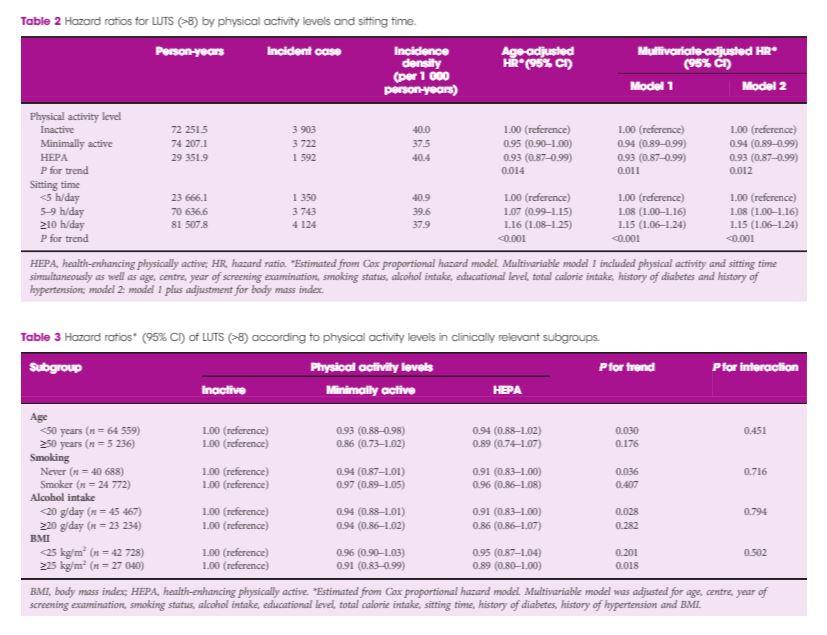Editorial: Exercise to prevent LUTS – myth and reality
The pathophysiology of LUTS is one of the most intriguing issues in urology and the conundrum remains unsolved. Their multifactorial origin imposes a differential diagnosis that is often quite straightforward but sometimes complicated and at times the enigma is cracked only ex adiuvantibus. Clinical trials and personal experience have showed us that patients rarely become asymptomatic albeit our therapeutic efforts, suggesting that part of the problem is in the ageing process. So the question comes as to whether we can halt or delay ageing. Clearly some people age without LUTS apart from a physiological decrease in urinary flow. What goes wrong in our patients that stay right in some other subjects? Most of us would like to have a pill that could fix every problem, an easy answer to swallow and remedy our troubles, but this is not always the case.
‘Lifestyle’ is one of the most frequently cited words with 1 330 000 000 on Google today, more than double the ‘hits’ for happiness (a mere 576 000 000). No doubt that behind the lifestyle mantra there is an industry that makes billions on lifestyle issues, but as there is usually ‘no smoke without fire’ there must be something to it. Who has never been advised to change his way of life? Probably none, but who actually takes up the challenge and changes their routine? Clinical trials on the therapeutic effect of lifestyle changes cannot be analysed with an intent‐to‐treat analysis because ‘there’s many a slip ‘twixt cup and lip’ and we need look at those who really undertake the challenge.
There is a growing body of evidence that a healthy lifestyle will not just help to prevent cancer and cardiovascular events or keep you ‘fit’, but will also reduce the risk of developing LUTS [1, 2]. In this issue of the BJUI, a paper from South Korea [3] provides rather convincing evidence that sitting for ≥10 h/day will increase your risk of storage and voiding symptoms, whilst doing exercise will reduce it. But what if you are a manager and your job is to read an endless number of reports each day? You cannot read whilst walking or doing exercise; you work for a living and LUTS may be the price you pay for a wealthier life.
As a surgeon I have an obsession for fixing things and making my patients better. If my patients have a sedentary job can I suggest a change in their lifestyle (not a change of job) that can counterbalance long sitting hours? The answer from the Korean cohort seems to be negative, as multivariate analysis of a subject cohort with long sitting hours suggested an increased risk of developing LUTS notwithstanding some exercise. I never thought that sitting was that bad but ‘est modus in rebus’ as Horace put it and probably sitting for too long is bad. Actually, my watch keeps telling me to stand at regular intervals, although I think I stand for too long in theatre (it also reminds me to breathe properly but that is another story).
This is a long way to say that I would rather be told what I can do right than be told what I am doing wrong. Is my personal risk of a poor outcome reversible? I think we have enough evidence from observational studies that exercise will reduce the risk of developing LUTS, but the time has come to embark on large prospective trials of LUTS treatment with lifestyle changes including exercise.
I have a number of patients who adopted a healthier lifestyle upon retirement (more info here about how they are doing it), lost weight, lowered their arterial pressure and their glucose levels, and their LUTS improved dramatically. What I need to know is whether this is the exception or whether this is the rule. These are not easy studies but I would rather work to answer an important academic question with a difficult and long‐term trial rather than doing an easier study that will not change the way we live and the way we practise.
References
- De Nunzio C, Presicce F, Lombardo R et al. Physical activity as a risk factor for prostate cancer diagnosis: a prospective biopsy cohort analysis. BJU Int 2016; 117: E29–35
- Gacci M, Corona G, Sebastianelli A et al. Male lower urinary tract symptoms and cardiovascular events: a systematic review and meta‐analysis. Eur Urol 2016; 70: 788–96
- Park HJ, Park CH, Chang Y, Ryu S. Sitting time, physical activity and the risk of lower urinary tract symptoms: a cohort study. BJU Int 2018; 122: 293–99


